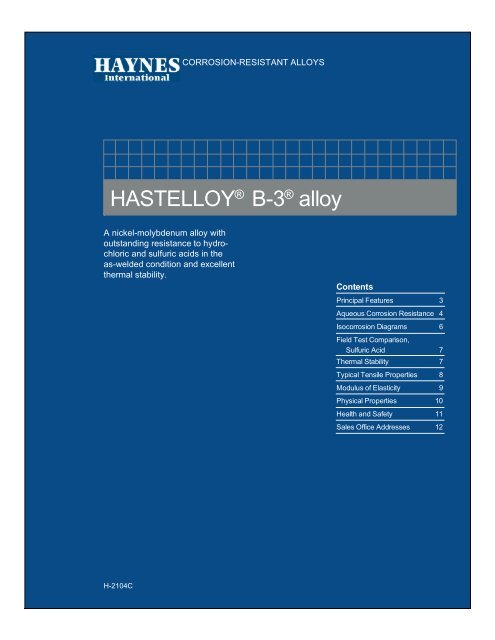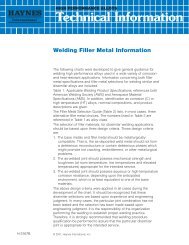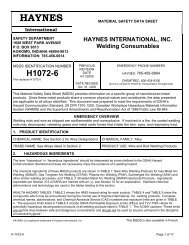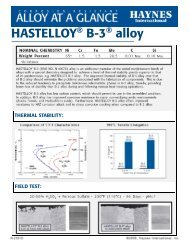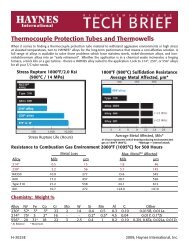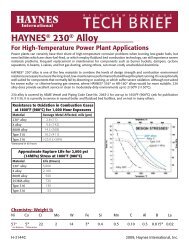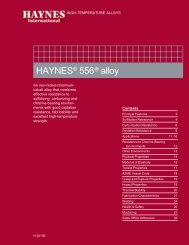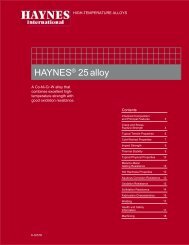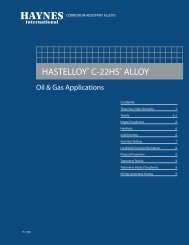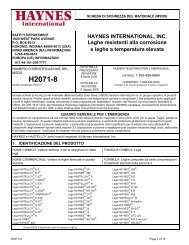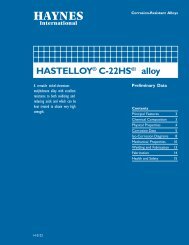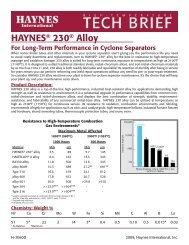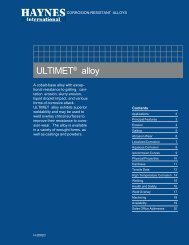HASTELLOY® B-3® alloy - Haynes International, Inc.
HASTELLOY® B-3® alloy - Haynes International, Inc.
HASTELLOY® B-3® alloy - Haynes International, Inc.
You also want an ePaper? Increase the reach of your titles
YUMPU automatically turns print PDFs into web optimized ePapers that Google loves.
CORROSION-RESISTANT ALLOYS<br />
HASTELLOY ® B-3 ® <strong>alloy</strong><br />
A nickel-molybdenum <strong>alloy</strong> with<br />
outstanding resistance to hydrochloric<br />
and sulfuric acids in the<br />
as-welded condition and excellent<br />
thermal stability.<br />
Contents<br />
Principal Features 3<br />
Aqueous Corrosion Resistance 4<br />
Isocorrosion Diagrams 6<br />
Field Test Comparison,<br />
Sulfuric Acid 7<br />
Thermal Stability 7<br />
Typical Tensile Properties 8<br />
Modulus of Elasticity 9<br />
Physical Properties 10<br />
Health and Safety 11<br />
Sales Office Addresses 12<br />
H-2104C
HASTELLOY ® B-3 ® <strong>alloy</strong><br />
2<br />
©1995, <strong>Haynes</strong> <strong>International</strong>, <strong>Inc</strong>.
PRINCIPAL FEATURES<br />
Outstanding Corrosion<br />
Resistance In The As-<br />
Welded Condition<br />
HASTELLOY ® B-3 ® <strong>alloy</strong> is an<br />
additional member of the<br />
nickel-molybdenum family of<br />
<strong>alloy</strong>s with excellent resistance<br />
to hydrochloric acid at all<br />
concentrations and temperatures.<br />
It also withstands<br />
sulfuric, acetic, formic and<br />
phosphoric acids, and other<br />
nonoxidizing media. B-3 <strong>alloy</strong><br />
has a special chemistry<br />
designed to achieve a level of<br />
thermal stability greatly superior<br />
to that of its predecessors,<br />
e.g. HASTELLOY B-2 <strong>alloy</strong>.<br />
B-3 <strong>alloy</strong> has excellent resistance<br />
to pitting corrosion, to<br />
stress-corrosion cracking and<br />
to knife-line and heat-affected<br />
zone attack.<br />
Fabrication<br />
The improved thermal stability<br />
of HASTELLOY B-3 <strong>alloy</strong><br />
minimizes the problems<br />
associated with fabrication of<br />
B-2 <strong>alloy</strong> components. This is<br />
due to the reduced tendency<br />
to precipitate deleterious<br />
intermetallic phases in B-3<br />
<strong>alloy</strong>, thereby, affording it<br />
greater ductility than B-2 <strong>alloy</strong><br />
during and following various<br />
thermal cycling conditions.<br />
HASTELLOY B-3 <strong>alloy</strong> has<br />
good overall forming and<br />
welding characteristics. It may<br />
be forged or otherwise hotworked,<br />
providing that it is<br />
held at 2250°F (1230°C) for a<br />
time sufficient to bring the<br />
entire piece to temperature.<br />
Since it is a low carbon <strong>alloy</strong>,<br />
the use of lower hot finishing<br />
temperatures may be necessary<br />
to achieve grain size<br />
control.<br />
B-3 <strong>alloy</strong> may also be formed<br />
by cold working. Although it<br />
does work-harden somewhat<br />
rapidly, B-3 <strong>alloy</strong> components<br />
can be made using all common<br />
cold forming techniques.<br />
Limited tests in boiling 20<br />
percent hydrochloric acid<br />
indicate that the uniform<br />
corrosion resistance of B-3<br />
<strong>alloy</strong> is not affected by cold<br />
reductions up to 50 percent as<br />
compared to that of the <strong>alloy</strong> in<br />
the solution heat-treated<br />
condition.<br />
B-3 <strong>alloy</strong> can be welded by all<br />
common welding techniques,<br />
although oxyacetylene and<br />
submerged arc welding<br />
processes are not recommended<br />
when the fabricated<br />
item is to be used in corrosive<br />
service. Special precautions<br />
should be taken to avoid<br />
excessive heat input.<br />
Heat Treatment<br />
All wrought forms of<br />
HASTELLOY B-3 <strong>alloy</strong> are<br />
furnished in the solution heattreated<br />
condition unless<br />
otherwise specified. B-3 <strong>alloy</strong><br />
is solution heat-treated at<br />
1950°F (1065°C) and rapid<br />
quenched, except for bright<br />
annealed sheet or coil products<br />
which are heat-treated at<br />
2100°F (1150°C) and cooled in<br />
hydrogen.<br />
Available in Wrought<br />
Form<br />
HASTELLOY B-3 <strong>alloy</strong> is<br />
available in the form of plate,<br />
sheet, strip, billet, bar, wire,<br />
pipe and tubing.<br />
Applications<br />
HASTELLOY B-3 <strong>alloy</strong> is<br />
suitable for use in all applications<br />
previously requiring the<br />
use of HASTELLOY B-2 <strong>alloy</strong>.<br />
Like B-2 <strong>alloy</strong>, B-3 is not<br />
recommended for use in the<br />
presence of ferric or cupric<br />
salts as these salts may cause<br />
rapid corrosion failure. Ferric<br />
or cupric salts may develop<br />
when hydrochloric acid comes<br />
in contact with iron or copper.<br />
ASME Boiler And Pressure<br />
Vessel Code<br />
ASME has published Code<br />
Case 2140 for solution annealed<br />
HASTELLOY B-3 <strong>alloy</strong><br />
(UNS N10675). The <strong>alloy</strong> is<br />
also covered by ASTM specifications<br />
B333 (plate, sheet and<br />
strip), B335 (bar), B366<br />
(welded fittings), B564<br />
(forgings), B619 (welded pipe),<br />
B622 (seamless pipe and<br />
tube) and B626 (welded tube).<br />
Nominal Chemical Composition, Weight Percent<br />
Ni Mo Cr Fe Co W Mn Al Ti Si C<br />
65 b 28.5 1.5 1.5 3* 3* 3* 0.5* 0.2* 0.1* 0.01*<br />
b Minimum<br />
* Maximum<br />
3 HASTELLOY ® B-3 ® <strong>alloy</strong>
AQUEOUS CORROSION RESISTANCE<br />
Average Uniform Corrosion Resistance in Boiling Acids*<br />
Average<br />
Concentration<br />
Corrosion Rate Per Year<br />
Acid Medium Weight Percent Mils mm<br />
Acetic Acid 10 0.2 0.005<br />
30 0.2 0.005<br />
50 0.2 0.005<br />
70 0.2 0.005<br />
99 (Glacial) 0.7 0.017<br />
Formic Acid 10 0.4 0.010<br />
20 0.6 0.015<br />
30 0.6 0.015<br />
40 0.5 0.013<br />
60 0.3 0.008<br />
89 0.2 0.005<br />
Hydrochloric Acid 1 0.3 0.005<br />
2 1.2 0.03<br />
5 3.8 0.10<br />
10 5.5 0.14<br />
15 8.6 0.22<br />
20 12.1 0.31<br />
(As-welded) 20 13.6 0.35<br />
(50 ppm Fe +3 ) 20 80.0 2.0<br />
Phosphoric Acid 10 2.4 0.06<br />
(Chemically Pure) 30 2.0 0.05<br />
50 3.0 0.08<br />
85 2.9 0.07<br />
Sulfuric Acid 2 0.4 0.010<br />
5 0.7 0.018<br />
10 0.8 0.020<br />
20 1.2 0.03<br />
30 1.2 0.03<br />
(50 ppm Fe +3 ) 30 18.8 0.48<br />
40 1.2 0.03<br />
50 1.7 0.04<br />
(As-welded) 50 2.4 0.06<br />
(Aged 48 Hrs @ 1000°F (540°C)) 50 2.0 0.05<br />
60 2.3 0.06<br />
70 6.6 0.17<br />
* Data from three production heats, for material in the solution heat-treated condition, unless noted.<br />
Test values were determined from an average of four 24 hour exposures.<br />
HASTELLOY ® B-3 ® <strong>alloy</strong><br />
4
Comparative Uniform Corrosion Resistance in Boiling Acids<br />
Average Corrosion Rates Per Year, Mils (mm)<br />
B-3 ® B-2 Type MONEL ® 400<br />
Acid Medium <strong>alloy</strong> <strong>alloy</strong> 316L <strong>alloy</strong><br />
50% Acetic Acid 0.2 (0.005) 0.4 (0.010) 0.2 (0.005) -<br />
40% Formic Acid 0.5 (0.013) 0.7 (0.018) 41 (1.041) 2.1 (0.053)<br />
50-55% Phosphoric Acid 3.0 (0.076) 6 (0.152) 18 (0.457) 4.5 (0.114)<br />
50% Sulfuric Acid 1.7 (0.043) 1.2 (0.030) >20,000 (>500) 185 (4.699)<br />
20% Hydrochloric Acid 12 (0.305) 15 (0.381) >20,000 (>500) 1587 (40.310)<br />
Average Uniform Corrosion Resistance in HF Solutions*<br />
Average Corrosion Rates Per Year For Indicated Temperatures<br />
125°F (52°C) 175°F (79°C)<br />
% HF Mils mm Mils mm<br />
1 8.6 0.22 11.1 0.28<br />
3 8.7 0.22 12.7 0.32<br />
5 9.0 0.23 13.7 0.35<br />
10 10.0 0.25 15.9 0.41<br />
20 11.8 0.30 22.8 0.58<br />
48 13.4 0.34 35.0 0.89<br />
70 31.6 0.80 - -<br />
* Data from three production heats, for material in the solution heat-treated condition.<br />
Comparative Stress Corrosion Cracking Resistance<br />
U-B end Specimens (ASTM G-30 Stress Method)<br />
664 86<br />
Boiling 60% H 2<br />
SO 4<br />
HASTELLOY ® B-3 <strong>alloy</strong><br />
Annealed + 1 hr at 1290°F (700°C)<br />
(No cracking, 24 hours)<br />
664 85<br />
HASTELLOY B-2 <strong>alloy</strong><br />
Annealed + 1 hr at 1290°F (700°C)<br />
(Intergranular cracking, 3 hours)<br />
Flat, Sheet Specimens<br />
Mill Annealed and Aged<br />
1 Hour at 1290°F (700°C)<br />
Boil ing B-2 B-3<br />
Sol utio n allo y allo y<br />
5%H 2<br />
SO 4<br />
IG-S CC NC**<br />
0.5% H 2<br />
SO 4<br />
IG-S CC NC<br />
20% HCl IG-S CC* NC<br />
* Intergranular stress-corrosion cracking<br />
at stamped identification sites.<br />
** No Cracking<br />
5 HASTELLOY ® B-3 ® <strong>alloy</strong>
AQUEOUS CORROSION RESISTANCE (continued)<br />
Effect of Cold Work Upon Corrosion Resistance in Boiling 20% HCl*<br />
Ultimate<br />
Corrosion<br />
Tensile Yield Strength Elongation Rate<br />
% Hardness Strength at 0.2% Offset in 2" (51mm) PerYear<br />
Coldwork Rc Ksi MPa Ksi MPa % EL Mils (mm)<br />
0 18 125 860 62 425 57 13 (0.33)<br />
10 30 140 965 100 690 40 13 (0.33)<br />
20 37 159 1095 130 895 25 13 (0.33)<br />
30 41 180 1240 154 1060 13 13 (0.33)<br />
40 44 202 1395 172 1185 9 13 (0.33)<br />
50 46 221 1525 183 1260 8 13 (0.33)<br />
* Exposure for four 24 hour periods<br />
HASTELLOY ® B-3 ® <strong>alloy</strong> ISOCORROSION DIAGRAMS<br />
Hydrochloric Acid<br />
Sulfuric Acid<br />
250<br />
Boiling Point Curve<br />
125<br />
400<br />
350<br />
>5 mpy<br />
(>0.13 mmpy)<br />
200<br />
200<br />
>5 mpy<br />
(>0.13 mmpy)<br />
100<br />
300<br />
250<br />
Boiling Point Curve<br />
150<br />
150<br />
100<br />
0<br />
5 to 20 mpy<br />
(0.13 to 0.51 mmpy)<br />
0 to 5 mpy<br />
(0.13 mmpy)<br />
10 20 30<br />
Concentration, wt.%<br />
40<br />
75<br />
50<br />
200<br />
150<br />
100<br />
0<br />
>5 mpy<br />
(>0.13 mmpy)<br />
10<br />
20<br />
30<br />
0 to 5 mpy<br />
(0 to 0.13 mmpy)<br />
40 50 60 70 80 90 100<br />
Concentration, wt.%<br />
100<br />
50<br />
350<br />
Phosphoric Acid<br />
300<br />
150<br />
250<br />
125<br />
200<br />
Boiling Point Curve<br />
>5 mpy<br />
(>0.13 mmpy)<br />
100<br />
150<br />
100<br />
0 to 5 mpy<br />
(0 to 0.13 mmpy)<br />
75<br />
50<br />
0<br />
10<br />
20<br />
30 40 50 60 70 80<br />
Concentration, wt.%<br />
HASTELLOY ® B-3 ® <strong>alloy</strong><br />
6
FIELD TEST COMPARISON, SULFURIC ACID<br />
20-30% H 2<br />
SO 4<br />
+ Ferrous Sulfate - 230°F (110°C) - 96 Days - pH
Average Thermal Stability Data (continued)<br />
Exposure Ultimate Tensile 0.2% Offset Yield Charpy V-Notch<br />
Temperature Exposure Strength Strength Elongation R of A Impact<br />
°F °C Time, Hrs. Ksi MPa Ksi MPa % % Ft.-lbs. J<br />
900 480 1000 140.8 970 77.5 535 50.0 67.1 262 355<br />
4000 144.6 995 84.0 580 48.3 65.5 264 358<br />
8000 139.2 960 80.5 555 48.9 64.4 210 285<br />
12,000 141.1 975 81.7 565 49.9 65.2 231 313<br />
16,000 147.7 1020 85.5 590 48.8 64.6 175 237<br />
1000 540 1000 145.8 1005 82.9 570 48.4 64.7 236 320<br />
4000 152.9 1055 89.1 615 45.6 61.4 107 145<br />
8000 152.0 1050 90.7 625 47.1 59.5 58 79<br />
12,000 153.6 1060 92.4 635 44.2 59.2 82 111<br />
16,000 162.7 1120 96.0 660 43.7 57.5 58 79<br />
1100 595 1000 169.2 1165 104.1 720 38.8 54.9 25 34<br />
4000 178.5 1230 117.8 810 31.5 37.2 15 20<br />
8000 175.3 1210 118.5 815 28.7 35.7 13 18<br />
12,000 178.1 1230 120.4 830 26.4 31.7 13 18<br />
16,000 186.0 1280 126.1 870 25.3 29.6 8 11<br />
TYPICAL TENSILE PROPERTIES<br />
Tensile Properties, Sheet*<br />
Test Ultimate Tensile Yield Strength Elongation<br />
Temperature Strength at 0.2% Offset in 2 in (51mm)<br />
°F °C Ksi MPa Ksi MPa %<br />
Room Room 125.0 860 60.6 420 53.4<br />
200 95 120.7 830 55.3 380 56.9<br />
400 205 110.0 760 47.0 325 59.7<br />
600 315 104.4 720 43.5 300 63.4<br />
800 425 102.0 705 42.4 290 62.0<br />
1000 540 97.8 675 39.0 270 59.0<br />
1200 650 103.5 715 45.8 315 55.8<br />
* Limited data for 0.125" (3.2mm) bright annealed sheet<br />
HASTELLOY ® B-3 ® <strong>alloy</strong><br />
8
Tensile Properties, Plate*<br />
Elongation<br />
Test Ultimate Tensile Yield Strength in 2 in (51mm) Reduction<br />
Temperature Strength at 0.2% Offset or in 5D* of Area*<br />
°F °C Ksi MPa Ksi MPa % %<br />
Room Room 128.3 885 58.2 400 57.8 67.5<br />
200 95 122.4 845 54.1 375 58.2 67.3<br />
400 205 115.1 795 47.6 330 60.9 68.1<br />
600 315 111.2 765 44.4 305 61.6 65.5<br />
800 425 108.2 745 41.3 285 61.7 64.9<br />
1000 540 105.6 730 39.6 275 61.7 61.5<br />
1200 650 106.9 735 42.0 290 64.6 54.9<br />
* Average results for six lots of plate from three heats. Half of the test data are for 1/4-inch (6.3mm) plate,<br />
requiring flat test specimens. Rest of samples were round geometry for heavier plate. Thus, reduction of<br />
areas reported are for these tests only.<br />
DYNAMIC MODULUS OF ELASTICITY<br />
Dynamic<br />
Dynamic<br />
Modulus of<br />
Modulus of<br />
Temperature Elasticity, Temperature Elasticity,<br />
°F 10 6 psi °C GPa<br />
Room 31.4 Room 216<br />
200 30.9 100 213<br />
400 30.1 200 208<br />
600 29.3 300 202<br />
800 28.3 400 197<br />
1000 27.2 500 190<br />
1200 26.5 600 185<br />
1400 24.9 700 178<br />
1600 23.3 800 168<br />
1800 21.6 900 157<br />
1000 147<br />
9<br />
HASTELLOY ® B-3 ® <strong>alloy</strong>
TYPICAL PHYSICAL PROPERTIES<br />
Physical Property Temp., °F British Units Temp., °C Metric Units<br />
Density Room 0.333 lb/in. 3 Room 9.22 g/cm. 3<br />
Melting Temperature 2500-2585 1370-1418<br />
Electrical Resistivity Room 53.8 microhm-in. Room 137 microhm-cm<br />
200 53.9 microhm-in. 100 137 microhm-cm<br />
400 54.1 microhm-in. 200 137 microhm-cm<br />
600 54.3 microhm-in. 300 138 microhm-cm<br />
800 54.4 microhm-in. 400 138 microhm-cm<br />
1000 55.4 microhm-in. 500 140 microhm-cm<br />
1200 57.5 microhm-in. 600 143 microhm-cm<br />
1400 54.7 microhm-in. 700 142 microhm-cm<br />
1600 52.6 microhm-in. 800 137 microhm-cm<br />
1800 51.2 microhm-in. 900 132 microhm-cm<br />
1000 130 microhm-cm<br />
Mean Coefficient of 78-200 5.7 microinches/in.-°F 25-100 10.6 x 10 -6 m/m-°C<br />
Thermal Expansion 78-400 6.1 microinches/in.-°F 25-200 11.1 x 10 -6 m/m-°C<br />
78-600 6.3 microinches/in.-°F 25-300 11.4 x 10 -6 m/m-°C<br />
78-800 6.5 microinches/in.-°F 25-400 11.6 x 10 -6 m/m-°C<br />
78-1000 6.6 microinches/in.-°F 25-500 11.8 x 10 -6 m/m-°C<br />
78-1200 6.5 microinches/in.-°F 25-600 11.8 x 10 -6 m/m-°C<br />
78-1400 7.1 microinches/in.-°F 25-700 12.2 x 10 -6 m/m-°C<br />
78-1600 7.6 microinches/in.-°F 25-800 13.1 x 10 -6 m/m-°C<br />
78-1800 8.0 microinches/in.-°F 25-900 13.9 x 10 -6 m/m-°C<br />
25-1000 14.4 x 10 -6 m/m-°C<br />
Thermal Diffusivity Room 4.6 x 10 -3 in. 2 /sec. Room 3.0 x 10 -3 cm 2 /sec.<br />
200 4.9 x 10 -3 in. 2 /sec. 100 3.2 x 10 -3 cm 2 /sec.<br />
400 5.4 x 10 -3 in. 2 /sec. 200 3.4 x 10 -3 cm 2 /sec.<br />
600 5.8 x 10 -3 in. 2 /sec. 300 3.7 x 10 -3 cm 2 /sec.<br />
800 6.3 x 10 -3 in. 2 /sec. 400 4.0 x 10 -3 cm 2 /sec.<br />
1000 6.8 x 10 -3 in. 2 /sec. 500 4.4 x 10 -3 cm 2 /sec.<br />
1200 7.3 x 10 -3 in. 2 /sec. 600 4.5 x 10 -3 cm 2 /sec.<br />
1400 7.5 x 10 -3 in. 2 /sec. 700 4.9 x 10 -3 cm 2 /sec.<br />
1600 7.0 x 10 -3 in. 2 /sec. 800 4.7 x 10 -3 cm 2 /sec.<br />
1800 7.4 x 10 -3 in. 2 /sec. 900 4.5 x 10 -3 cm 2 /sec.<br />
1000 4.9 x 10 -3 cm 2 /sec.<br />
Acknowledgements:<br />
MONEL is a registered trademark of the <strong>Inc</strong>o Family of Companies.<br />
HASTELLOY ® B-3 ® <strong>alloy</strong><br />
10
Typical Physical Properties (continued)<br />
Physical Property Temp., °F British Units Temp., °C Metric Units<br />
Thermal Conductivity Room 78 Btu-in./ft. 2 hr.-°F Room 11.2 W/m-K<br />
200 83 Btu-in./ft. 2 hr.-°F 100 12.1 W/m-K<br />
400 93 Btu-in./ft. 2 hr.-°F 200 13.4 W/m-K<br />
600 104 Btu-in./ft. 2 hr.-°F 300 14.8 W/m-K<br />
800 116 Btu-in./ft. 2 hr.-°F 400 16.3 W/m-K<br />
1000 129 Btu-in./ft. 2 hr.-°F 500 17.9 W/m-K<br />
1200 142 Btu-in./ft. 2 hr.-°F 600 19.6 W/m-K<br />
1400 156 Btu-in./ft. 2 hr.-°F 700 21.4 W/m-K<br />
1600 172 Btu-in./ft. 2 hr.-°F 800 23.3 W/m-K<br />
1800 188 Btu-in./ft. 2 hr.-°F 900 25.4 W/m-K<br />
1000 27.5 W/m-K<br />
Specific Heat Room 0.089 Btu/lb.-°F Room 373 J/kg-K<br />
200 0.092 Btu/lb.-°F 100 382 J/kg-K<br />
400 0.098 Btu/lb.-°F 200 409 J/kg-K<br />
600 0.102 Btu/lb.-°F 300 421 J/kg-K<br />
800 0.104 Btu/lb.-°F 400 431 J/kg-K<br />
1000 0.104 Btu/lb.-°F 500 436 J/kg-K<br />
1200 0.112 Btu/lb.-°F 600 434 J/kg-K<br />
1400 0.143 Btu/lb.-°F 700 595 J/kg-K<br />
1600 0.138 Btu/lb.-°F 800 589 J/kg-K<br />
1800 0.137 Btu/lb.-°F 900 577 J/kg-K<br />
1000 575 J/kg-K<br />
HEALTH AND SAFETY<br />
Welding can be a safe occupation.<br />
Those in the welding<br />
industry, however, should be<br />
aware of the potential hazards<br />
associated with welding fumes,<br />
gases, radiation, electric shock,<br />
heat, eye injuries, burns, etc.<br />
Also, local, municipal, state, and<br />
federal regulations (such as<br />
those issued by OSHA) relative<br />
to welding and cutting processes<br />
should be considered.<br />
Nickel-, cobalt-, and iron-base<br />
<strong>alloy</strong> products may contain, in<br />
varying concentration, the<br />
following elemental constituents:<br />
aluminum, cobalt, chromium,<br />
copper, iron, manganese,<br />
molybdenum, nickel and<br />
tungsten. For specific concentrations<br />
of these and other elements<br />
present, refer to the Material<br />
Safety Data Sheets (MSDS)<br />
available from <strong>Haynes</strong> <strong>International</strong>,<br />
<strong>Inc</strong>.<br />
Inhalation of metal dust or fumes<br />
generated from welding, cutting,<br />
grinding, melting, or dross<br />
handling of these <strong>alloy</strong>s may<br />
cause adverse health effects<br />
such as reduced lung function,<br />
nasal and mucous membrane<br />
irritation. Exposure to dust or<br />
fumes which may be generated in<br />
working with these <strong>alloy</strong>s may<br />
also cause eye irritation, skin<br />
rash and effects on other organ<br />
systems.<br />
The operation and maintenance<br />
of welding and cutting equipment<br />
should conform to the provision<br />
of American National Standard<br />
ANSI/AWS Z49.1, "Safety in<br />
Welding and Cutting". Attention<br />
is especially called to Section 4<br />
(Protection of Personnel) and 5<br />
(Health Protection and Ventilation)<br />
of ANSI/AWS Z49.1.<br />
Mechanical ventilation is advisable<br />
and, under certain conditions<br />
such as a very confined<br />
space, is necessary during<br />
welding or cutting operations, or<br />
both, to prevent possible exposure<br />
to hazardous fumes, gases,<br />
or dust that may occur.<br />
11 HASTELLOY ® B-3 ® <strong>alloy</strong>
STANDARD PRODUCTS<br />
By Brand or Alloy Designation:<br />
HAYNES<br />
<strong>International</strong><br />
HASTELLOY ® Family of Corrosion-Resistant Alloys<br />
B-3 ® , C-4, C-22 ® , C-276, C-2000 ® , C-22HS ® , G-30 ® , G-35 ® , G-50 ® , HYBRID-BC1, and N<br />
HASTELLOY Family of Heat-Resistant Alloys<br />
S, W, and X<br />
HAYNES ® Family of Heat-Resistant Alloys<br />
25, R-41, 75, HR-120 ® , HR-160 ® , 188, 214 ® , 230 ® , 230-W ® , 242 ® , 263, 282 ® , 556 ® , 617, 625, 65SQ ® , 718,<br />
X-750, MULTIMET ® , NS-163, and Waspaloy<br />
Corrosion-Wear Resistant Alloy<br />
ULTIMET ®<br />
Wear-Resistant Alloy<br />
6B<br />
HAYNES Titanium Alloy Tubular<br />
Ti-3Al-2.5V<br />
Standard Forms: Bar, Billet, Plate, Sheet, Strip, Coils, Seamless or Welded Pipe & Tubing,<br />
Pipe Fittings, Flanges, Fittings, Welding Wire, and Coated Electrodes<br />
Properties Data: The data and information in this<br />
publication are based on work conducted principally by<br />
<strong>Haynes</strong> <strong>International</strong>, <strong>Inc</strong>. and occasionally supplemented by<br />
information from the open literature, and are believed to be<br />
reliable. However, <strong>Haynes</strong> does not make any warranty or<br />
assume any legal liability or responsibility for its accuracy,<br />
completeness, or usefulness, nor does <strong>Haynes</strong> represent that<br />
its use would not infringe upon private rights.<br />
Any suggestions as to uses and applications for specific <strong>alloy</strong>s<br />
are opinions only and <strong>Haynes</strong> <strong>International</strong>, <strong>Inc</strong>. makes no<br />
warranty of results to be obtained in any particular situation.<br />
For specific concentrations of elements present in a particular<br />
product and a discussion of the potential health affects<br />
thereof, refer to the Material Safety Data Sheet supplied by<br />
<strong>Haynes</strong> <strong>International</strong>, <strong>Inc</strong>. All trademarks are owned by<br />
<strong>Haynes</strong> <strong>International</strong>, <strong>Inc</strong>.<br />
050907<br />
Global Headquarters<br />
1020 West Park Avenue<br />
P.O. Box 9013<br />
Kokomo, Indiana 46904-9013 (USA)<br />
Phone: 1-800-354-0806 or (765) 456-6012<br />
Fax: (765) 456-6905<br />
www.haynesintl.com<br />
For your local sales office or service center, please call or visit our website.


